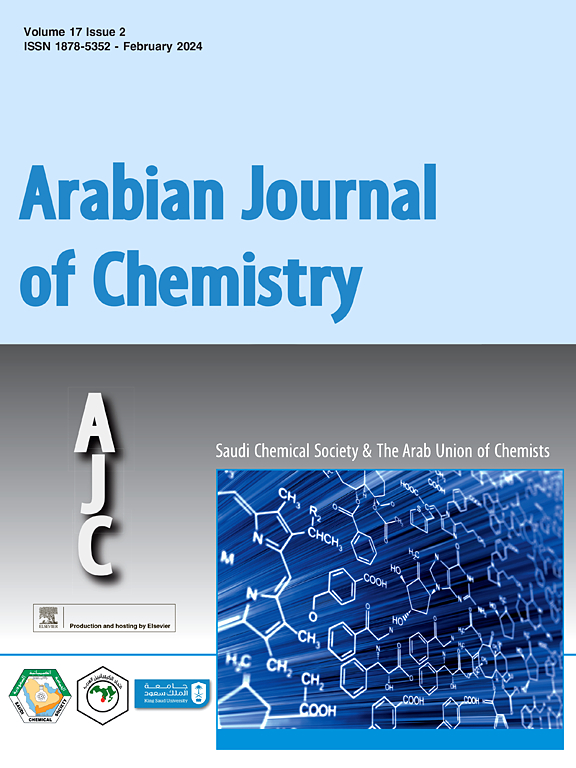The reaction mechanism of p-hydroxystyryl-substituted BODIPY with ABTS•+ and Fe3+ in solutions and in liposomes
IF 5.2
2区 化学
Q2 CHEMISTRY, MULTIDISCIPLINARY
引用次数: 0
Abstract
The reaction mechanism of p-hydroxystyryl-substituted BODIPY (BOH) with two oxidative cations, namely ABTS•+ and Fe3+, was investigated in a water–ethanol mixed solution and in liposome suspensions, respectively, using different spectroscopic methods. In solution, the oxidation of BOH (with orange fluorescence) by the two cations occurred at the ethylene group (C![]() C) locating between the dipyrrole and phenol groups and resulted in conjugation-truncated products exhibiting characteristic green fluorescence emission. In heterogeneous small unilamellar vesicles (SUV), water soluble ABTS•+ was evidenced to oxidize BOH embedded in the lipid bilayers of SUV, while Fe3+ did not. The lack of reaction between Fe3+ and BOH was attributed to the complexation between Fe3+ and the phenolic hydroxyl group of BOH on the surface of the SUV. The reaction kinetics results indicated that, in homogeneous solution, the oxidation rate of Fe3+ was three orders of magnitude slower than that of ABTS•+ for BOH. The location and orientation of BOH within the SUV were discussed based on the reaction phenomena. BOH could be as a good antioxidant fluorescent prober for ABTS•+ detection with a detection limit of 1.5 * 10−7 M and a linear rang of 0–4.93 μM. What’s more, the amphiphilic BOH dispersed in the round GUV (BOH + GUV) could show the bright red fluorescence. This research suggests the significant potential of BOH as an antioxidant fluorescent probe for in situ bioimaging.
C) locating between the dipyrrole and phenol groups and resulted in conjugation-truncated products exhibiting characteristic green fluorescence emission. In heterogeneous small unilamellar vesicles (SUV), water soluble ABTS•+ was evidenced to oxidize BOH embedded in the lipid bilayers of SUV, while Fe3+ did not. The lack of reaction between Fe3+ and BOH was attributed to the complexation between Fe3+ and the phenolic hydroxyl group of BOH on the surface of the SUV. The reaction kinetics results indicated that, in homogeneous solution, the oxidation rate of Fe3+ was three orders of magnitude slower than that of ABTS•+ for BOH. The location and orientation of BOH within the SUV were discussed based on the reaction phenomena. BOH could be as a good antioxidant fluorescent prober for ABTS•+ detection with a detection limit of 1.5 * 10−7 M and a linear rang of 0–4.93 μM. What’s more, the amphiphilic BOH dispersed in the round GUV (BOH + GUV) could show the bright red fluorescence. This research suggests the significant potential of BOH as an antioxidant fluorescent probe for in situ bioimaging.
对羟基苯乙烯基取代的 BODIPY 与 ABTS-+ 和 Fe3+ 在溶液和脂质体中的反应机理
采用不同的光谱方法,研究了对羟基苯乙烯基取代的 BODIPY(BOH)分别在水-乙醇混合溶液和脂质体悬浮液中与 ABTS-+ 和 Fe3+ 两种氧化阳离子的反应机理。在溶液中,这两种阳离子对 BOH(具有橙色荧光)的氧化作用发生在位于二吡咯基团和苯酚基团之间的乙烯基团(CC)上,并导致共轭截断产物显示出特有的绿色荧光发射。在异质小型单拉米尔囊泡中,水溶性 ABTS-+ 被证明能氧化嵌入 SUV 脂质双分子层中的 BOH,而 Fe3+ 却不能。Fe3+ 与 BOH 不发生反应的原因是 Fe3+ 与 BOH 表面的酚羟基发生了络合反应。反应动力学结果表明,在均相溶液中,Fe3+ 对 BOH 的氧化速率比 ABTS-+ 慢三个数量级。根据反应现象讨论了 BOH 在 SUV 中的位置和取向。BOH 可作为一种良好的抗氧化荧光促进剂用于 ABTS-+ 的检测,其检测限为 1.5 * 10-7 M,线性范围为 0-4.93 μM。此外,分散在圆形 GUV(BOH + GUV)中的两亲性 BOH 还能发出明亮的红色荧光。这项研究表明,BOH 作为一种抗氧化荧光探针在原位生物成像方面具有巨大的潜力。
本文章由计算机程序翻译,如有差异,请以英文原文为准。
求助全文
约1分钟内获得全文
求助全文
来源期刊

Arabian Journal of Chemistry
CHEMISTRY, MULTIDISCIPLINARY-
CiteScore
10.80
自引率
3.30%
发文量
763
审稿时长
63 days
期刊介绍:
The Arabian Journal of Chemistry is an English language, peer-reviewed scholarly publication in the area of chemistry. The Arabian Journal of Chemistry publishes original papers, reviews and short reports on, but not limited to: inorganic, physical, organic, analytical and biochemistry.
The Arabian Journal of Chemistry is issued by the Arab Union of Chemists and is published by King Saud University together with the Saudi Chemical Society in collaboration with Elsevier and is edited by an international group of eminent researchers.
 求助内容:
求助内容: 应助结果提醒方式:
应助结果提醒方式:


